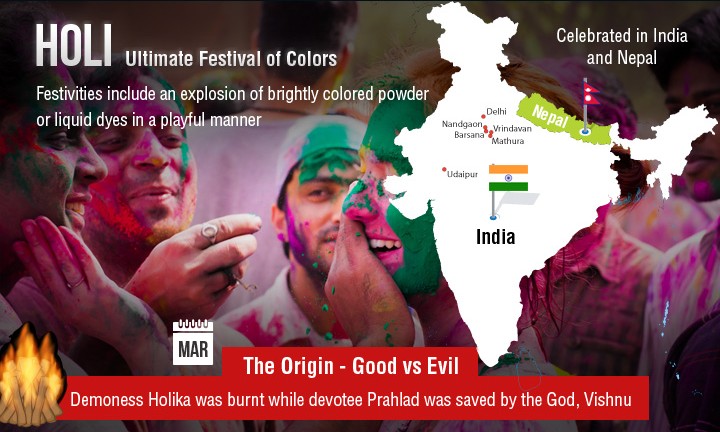Holi is a popular Hindu festival, also known as the “Festival of Colors” or the “Festival of Love”. It is a two-day festival celebrated in the spring season in India and other parts of the world. The festival marks the triumph of good over evil, the arrival of spring, and the end of winter. Holi is a time to forgive, forget, and renew relationships, and is celebrated with colors, music, dance, and feasting. It is a festival that brings people of all ages, castes, and religions together, promoting unity, brotherhood, and harmony. The festival is celebrated with great enthusiasm and fervor across India, and has gained popularity in other countries as well.
History and Origin of Holi Festival
The history and origin of Holi festival dates back to ancient India and has its roots in Hindu mythology. It is believed that the festival originated as a celebration of the victory of good over evil and the arrival of spring. The most popular legend associated with the festival is that of Prahlad and Hiranyakashipu.
Prahlad was a young devotee of Lord Vishnu, while Hiranyakashipu was his demon king father who demanded that his son worship him instead of Lord Vishnu. When Prahlad refused, Hiranyakashipu tried to kill him multiple times, but Lord Vishnu always saved him. Finally, Hiranyakashipu’s sister Holika, who had a boon to not be harmed by fire, sat on a pyre with Prahlad on her lap. However, due to the grace of Lord Vishnu, Prahlad emerged unharmed while Holika burnt to ashes. This is the origin of the tradition of lighting bonfires on the night before Holi, which is called Holika Dahan.
Apart from this, the festival is also associated with the love story of Lord Krishna and Radha. It is believed that Lord Krishna, who had a dark complexion, was jealous of Radha’s fair skin. His mother, Yashoda, suggested that he apply color on Radha’s face to make her complexion similar to his own. Lord Krishna and Radha’s playful use of colors became the origin of the modern-day Holi festival.
Holi in Vrindavan Mathura
Holi in Vrindavan and Mathura is considered to be the most famous and lively celebration of this festival in India. These cities, located in the state of Uttar Pradesh, are known for their unique traditions and customs during Holi. The week-long celebrations in these cities include throwing of colors and water, singing and dancing, and the famous Lathmar Holi in Barsana, where women playfully beat men with sticks. Thousands of people from around the world visit Vrindavan and Mathura during Holi to experience the vibrant and festive atmosphere.
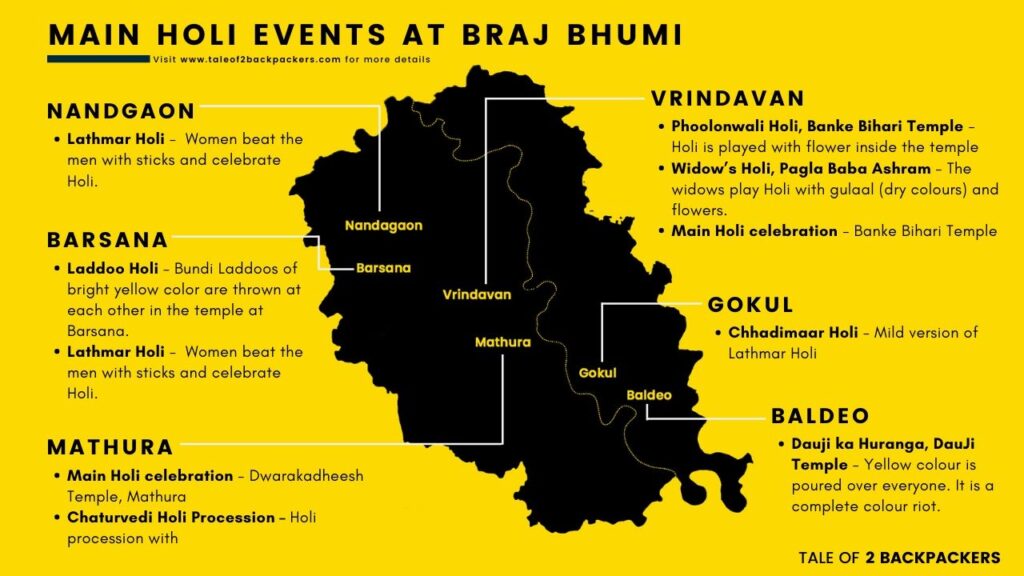
Types of Holi
-
Lathmar Holi, Barsana
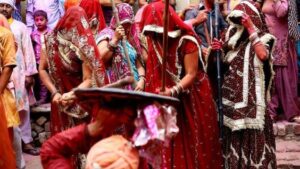
Lathmar Holi is a unique and popular tradition that takes place in the town of Barsana, located in the Mathura district of Uttar Pradesh, India. It is celebrated a few days before the actual day of Holi and is a major attraction for tourists and visitors from all over India and the world.
In Lathmar Holi, women chase men with sticks (called lathis) and men try to protect themselves with shields. It is believed to be based on a legend from Hindu mythology where Lord Krishna visited the town of Barsana and playfully teased the women, who chased him away with sticks. The tradition is said to symbolize the power dynamics between men and women and the joyous spirit of playfulness and love associated with the festival of Holi.
During Lathmar Holi, people gather in the narrow lanes and streets of Barsana, singing and dancing to the beat of drums and other musical instruments. The festival is also known for the vibrant colors and flower petals that are thrown around, creating a colorful and festive atmosphere.
Where – Barsana
When – The day after Falgun Shukla Ashtami
-
Laddoo Holi, Barsana
“Laddoo Holi” is a unique and playful tradition of Holi celebrated in the town of Barsana in Uttar Pradesh, India. The highlight of the festival is the distribution of laddoos (sweet balls made of flour, sugar, and nuts) by the women to the men as a sign of love and affection. It is a fun and lively festival that attracts tourists from all over the world.
Where – Barsana
When – Falgun Shukla Ashtami
-
Chhadimar Holi, Gokul
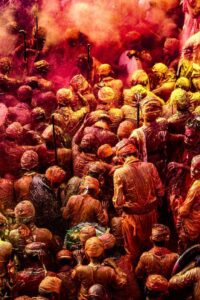
Chhadimar Holi is a unique festival celebrated in the town of Gokul, Uttar Pradesh, India. It is a popular event during the Holi festival, which usually falls in March. During Chhadimar Holi, men dress up as women and carry sticks with them as they go from house to house, playfully beating the women with the sticks. Women are allowed to reciprocate by chasing the men and playfully hitting them back. The festival is believed to be a re-enactment of Lord Krishna’s playful teasing of the gopis (milkmaids) in Gokul during his childhood. The festival is a symbol of love, friendship, and community bonding.
Where – Gokul
When – The day after Ekadashi
-
Phoolonwali Holi
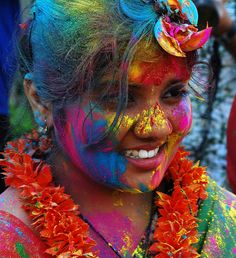
Phoolonwali Holi is a unique and colorful celebration of Holi that takes place in the city of Vrindavan in India. The festival is held on Ekadashi, the 11th day of the Hindu month of Phalguna (February/March), and involves the throwing of flowers instead of colored powder. The celebration is said to have originated from the love story of Lord Krishna and Radha, who used to play Holi with flowers in the forests of Vrindavan. During Phoolonwali Holi, people sing devotional songs, dance, and offer prayers to Lord Krishna and Radha. The festival attracts both locals and tourists who come to witness the unique and beautiful spectacle of flowers flying through the air.
Where – Banke Bihari temple, Vrindavan
When – Ekadashi before Holi
-
Widow’s Holi, Vrindavan
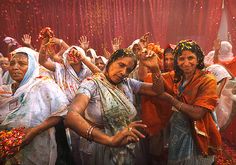
Widow’s Holi is a unique celebration that takes place in the town of Vrindavan, Uttar Pradesh, India. The festival is meant to empower widows, who are often shunned and neglected in Indian society, and allow them to participate in the joyous celebration of Holi. In this festival, widows wear white sarees and participate in the festivities by throwing flower petals and colored powder at each other. The festival is organized by non-profit organizations working towards the welfare of widows, and is a step towards giving them a chance to live with dignity and respect in society.
Where – Pagla Baba Ashram, Vrindavan
When – Around Afternoon
Here is 5 Facts About Holi
- The best Holi in India is played in Vrindavan, Mathura and Barsana.
- It Lasts For Two Days.
- It Marks The End Of Winter.
- Adults Drink Bhaang Thandai.
- Colors Have Symbolic Meanings
Significance and Traditions of Holi Festival
Holi is a festival of colors and is celebrated with great enthusiasm and fervor in India and other parts of the world. The festival signifies the victory of good over evil, the arrival of spring, and the end of winter.
The main tradition of Holi is the playing of colors, where people throw colored powders and water on each other. This is symbolic of the vibrant colors of spring and the new beginnings it brings.
Another important tradition of Holi is the lighting of bonfires on the eve of the festival, known as Holika Dahan. This represents the victory of good over evil, and the burning of the demoness Holika, who tried to kill the god Prahlad but was ultimately defeated.
In addition to playing with colors and lighting bonfires, Holi is also a time for people to come together and celebrate with their friends, family, and loved ones. People prepare and share traditional foods, sing and dance, and exchange greetings and well wishes.
Overall, Holi is a festival that celebrates the joys of spring, the victory of good over evil, and the importance of coming together with loved ones to celebrate life and new beginnings.

